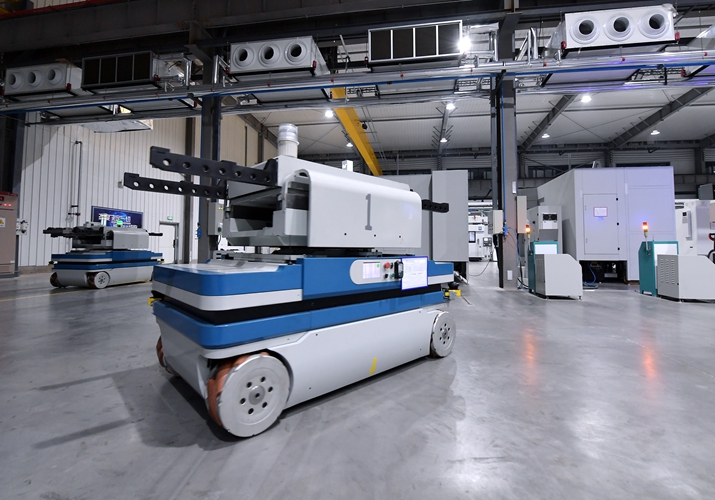| Voice |
| The Chinese economy has continued to expand despite headwinds | |
|
|
 An unmanned carrier with artificial intelligence and 5G technologies operates in the workshop of a digital technology company in Zaozhuang, Shandong Province in east China, on October 26(XINHUA)
 The Chinese economy, which plays a key role in driving global economic growth in the era of globalization, has seen steady progress during the 13th Five-Year Plan (2016-20) period. Despite worldwide economic slowdown and volatility during the period, China's growth has brought it to the forefront of the world's major economies and made it a key driving force of the global economy. After bringing the novel coronavirus disease epidemic under control domestically, China has resumed economic and social activities. The Chinese economy, which plays a key role in driving global economic growth in the era of globalization, has seen steady progress during the 13th Five-Year Plan (2016-20) period. Despite worldwide economic slowdown and volatility during the period, China's growth has brought it to the forefront of the world's major economies and made it a key driving force of the global economy. After bringing the novel coronavirus disease epidemic under control domestically, China has resumed economic and social activities.During the 13th Five-Year Plan period, China's economy has faced severe domestic and external challenges. The global economy has entered a phase of economic slowdown and volatility in the long economic cycle since 2014, which may last for 10-15 years. The rise in the cost of production factors including land and labor as well as the emergence of asset bubbles starting from the 11th Five-Year Plan (2006-10) period have made it increasingly hard to achieve sustainable growth through traditional economic modes. The pressure caused by the aging population since the 12th Five-Year Plan (2011-15) period is also mounting.
Internationally, the United States listed China as its largest strategic competitor in 2017. In 2018, it launched a trade war against China. Besides the threat of decoupling and a new cold war triggered by the U.S., the multilateral trade systems represented by the World Trade Organization are on the verge of collapse. Since the beginning of this year, the unprecedented novel coronavirus epidemic has affected China severely.
Facing the challenges, the Chinese economy has still made strides during the 13th Five-Year Plan period. China saw its GDP expand from more than 68 trillion yuan ($10.3 trillion) in 2015 to some 99 trillion yuan ($14.7 trillion) in 2019, joining the United States as the world's only two economies with $10-trillion annual GDP, far higher than that of other economic powers. In 2010, China's nominal GDP surpassed that of Japan for the first time. Although Japan ranks third in the world in terms of the economic scale, its GDP is now about one third of that of China. The GDP of other top 10 economies such as Italy, Canada and Brazil is less than 20 percent of China's.
Industrial foundation
The foundation of the modern economy lies in the manufacturing industry, which provides a key driving force for the service industry. Since the founding of the People's Republic of China in 1949, it has focused on developing the manufacturing industry. During the 11th Five-Year Plan period, China surpassed the United States as the world's largest manufacturing power. In the 12th and 13th Five-Year Plan periods, it maintained the status with increasing industrial output and improving industrial structure. Its steel output increased from some 1.03 billion tons to 1.2 billion tons and the automobile output expanded from 24.5 million to 25.5 million units from 2015 to 2019. The production volume of integrated circuits also rose from 108.72 billion to 201.8 billion in the period.
The U.S. used to be the dominant manufacturing power in the world. It produced 47.89 million tons of raw steel in 1939, which was equivalent to the steel output of Britain, France, Germany, Italy and Japan combined. China's steel output is now over 11 times that of the U.S.
China has also achieved notable growth in the hi-tech industry, especially information technology (IT). The manufacturing of electronic devices including computers and communication equipment has gained prominence in China's economy. The assets of the companies in these sectors account for about 9 percent of those of leading industrial enterprises above designated size, and the average number of workers they employ accounts for about 10 percent. The IT companies contribute about 20 percent of China's total export value.
The share of China's IT industry in the global market has notably expanded during the 13th Five-Year Plan period. While the Swedish telecom company Ericsson and Finland-based network equipment manufacturer Nokia saw their respective market shares reach 20 percent and 18 percent, China's telecom companies Huawei and ZTE take up around 36 percent and 12 percent respectively in the global telecommunication device market, with the share of all the other companies totaling 14 percent. China has also made great progress in manufacturing IT components such as liquid crystal panels and integrated circuits. During the 14th Five-Year Plan (2021-25) period, China is expected to occupy a major share in the global market of such products.
China has caught up as a late starter in the development of cutting-edge industries such as mobile communication. Although it introduced 1G and 3G technologies six years after the earliest commercial use of the technologies in the world and 2G and 4G technologies three years later than the world's earliest commercialization, it has launched 5G ahead of many countries.
 An unmanned carrier with artificial intelligence and 5G technologies operates in the workshop of a digital technology company in Zaozhuang, Shandong Province in east China, on October 26(XINHUA)
Growth drivers
China has further consolidated its position as the largest exporter of global goods, with its status in global service trade rising. Along with economic and industrial development, the income and living standards of the Chinese have improved significantly during the 13th Five-Year Plan period. In 2015-19, China's per-capita disposable income increased from 21,966 yuan ($3,286) to 30,733 yuan ($4,597). The poor population in rural areas declined from 54.54 million to 5.51 million. China is expected to eliminate absolute poverty and complete building a moderately prosperous society this year, fulfilling the commitment of the Chinese Government to its people and setting an example for the global poverty alleviation drive.
The increase in income has driven consumption upgrade in China and propelled the consumer market. China's national per-capita consumption expenditure rose from 15,712.4 yuan ($2,350) to 21,558.9 yuan ($3,225) from 2015 to 2019. The expansion of the Chinese consumer market has brought more opportunities to its trading partners.
Economic development has enhanced the revenue of the Chinese Government. China's general public budget revenue rose from around 15 trillion yuan ($2.2 trillion) to over 19 trillion yuan ($2.8 trillion) and the expenditure rose from about 17 trillion yuan ($2.5 trillion) to more than 23 trillion yuan ($3.4 trillion) between 2015 and 2019. The increase of revenue has allowed the government to improve budgets on public services and better launch macro control. It has also enabled China to provide more public goods for the international community.
China's role in stabilizing global economic and social development has enhanced along with its economic growth, which served as a regional economic stabilizer during the 1997-98 financial crisis in East Asia and contributed to global economic stability in the global financial crisis that broke out in 2008. China's economic development has contributed to global economic growth during the 13th Five-Year Plan period and remained resilient during the anti-epidemic battle. Chinese producers met over half of the global demand for masks, which surged 87 percent in the first half of this year, sustaining supply chains.
Following positive growth in the second quarter this year, China continued to see economic expansion in the third quarter, resuming positive year-on-year economic growth for the first time. The International Monetary Fund projected it to be the only major economy that will see economic expansion this year. China's GDP growth is expected to rebound to 8 percent and even 9 percent next year, which can ensure a good start for the upcoming 14th Five-Year Plan period.
The author is an op-ed contributor to Beijing Review and a researcher with the Chinese Academy of International Trade and Economic Cooperation
(Print Edition Title: A Pillar of Growth)
Copyedited by Madhusudan Chaubey
Comments to yanwei@bjreview.com
|
|
||||||||||||||||||||||||||||
|